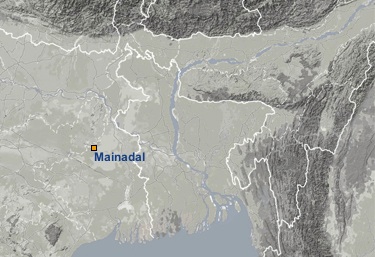Mainadal, Birbhum. 19 August 2014. Nityananda Mitra Thakur
Mainadal is a village in Birbhum district, West Bengal, 215 km northwest of Kolkata. It is home of the famous Mitra Thakur family, known for their practice of kirtan around the shrine of Chaitanya Mahaprabhu, who has been their house deity since the beginning of Vaishnavism in Bengal, about 500 years ago. We reached Mainadal tracing a link from a set of sound recordings in the archives of the British Library. These recordings, made on wax cylinders by the Dutch scholar Arnold Bake in 1933, mention both Mainadal as the place of recording and the Mitra Thakurs as the artists being recorded–Haridas Mitra Thakur, Haladhar Mitra Thakur, Advaita Chandra Mitra Thakur, Nabagopal Mitra Thakur, Sanket Bihari Mitra Thakur, Gour Gopal Mitra Thakur and Kaliakanta Mitra Thakur.
It was a bit of an adventure identifying the place and the practice and then finding the contacts through whom to reach Mainadal. But once contact was established, things began to flow quite smoothly. The Mitra Thakurs heard of our interest in their music and invited us over to their Janmashtami or Nandotsav festival, which is the celebration of the birth of Krishna.
So, we went to Mainadal for the first time on 19 August 2014. Arnold Bake had been there 81 years before us; his recording dates were 12-14 August 1933, and we know now that in 1933, that was indeed the time of Nandotsav–the end of the monsoon month of Sravan and the beginning of Bhadra.
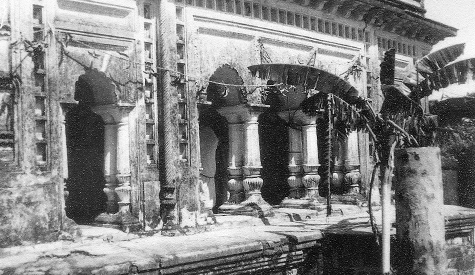
Mainadal old temple. Photo courtesy: Milan Mitra Thakur.
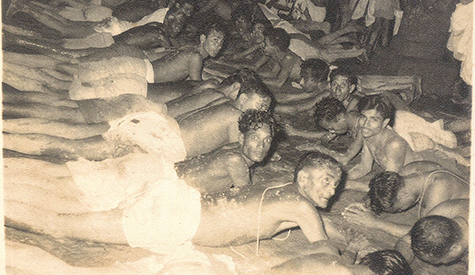

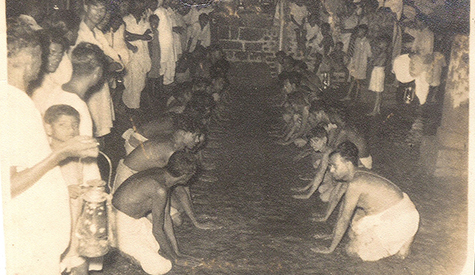

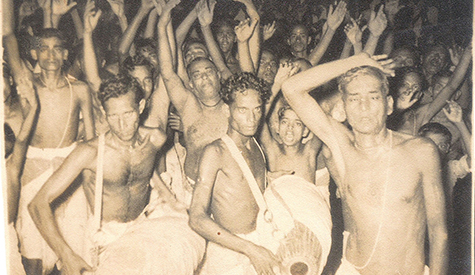

Old photographs of the annual festival of Mainadal. Photo courtesy: Milan Mitra Thakur. Photos taken by Pulak Dutta and Masyuaki Onishi during their trip to Mainadal in 1980.
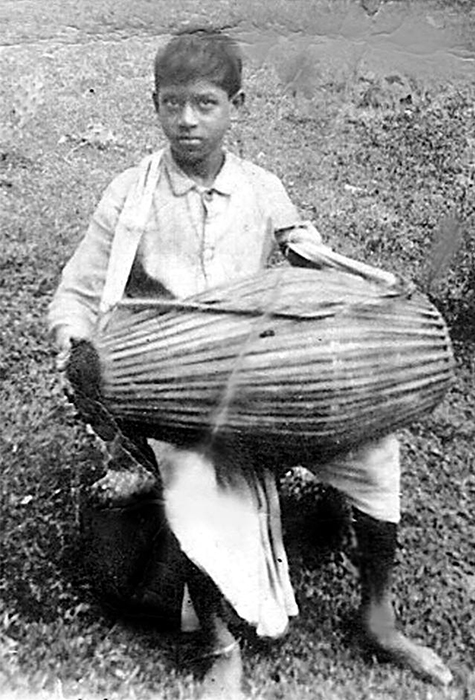
An eminent mridanga player, Kaliakanta Mitra Thakur.(or Kaliyakanta, as Arnold Bake wrote). This photograph is at least 80-85 years old, when Kaliakanta was a boy of eight or nine.
Milan Mitra Thakur sent us this photograph and wrote in an email: “মিত্রঠাকুরদের শৈশব শুরু হত এই পথে। শৈশবেই নির্ধারিত হত জীবনদিশা। এই ফোটোগ্রাফটি মৃদঙ্গ-বিশারদ কালিয়াকান্ত মিত্র ঠাকুরের (নির্মলের বাবা) ৮-৯ বছর বয়সের ছবি।”
Who might have taken this picture, is a matter of speculation. In fact, who took all the rest of the old photographs? Could it have been Arnold Bake himself? After all, he took pictures and sometimes filmed too wherever he went, especially for recording. Besides, Kaliakanta was recorded by Bake, along with his father Haridas Mitra Thakur. The British Library shelfmark is C52/1918 and the note in the catalogue reads like this: ‘Bake India II, No.269 (1931-33). Male solo recitation with drums and cymbals. Bake’s notes: “Kirtan from Mainadal 12-14/8/’33. [Kirtan tals] 12. shashishekara, 14. bororupak, 19. ?oj [Doj]. Haridas M.Th. [Mitra Thakur] cymbals with mistakes Kaliyakanta M.Th.” Reasonable quality recording.’
We have recorded many sessions of music performed by Kaliakanta’s sons, Nirmalendu, who is a beautiful singer, and Sachchidananda, one of the last remaining musicians to hold the great tradition of the Mitra Thakurs’ khol playing and recitation of what Bake called ‘drum poems’.
The large and extended family of the Mitra Thakurs were not aware of Bake’s visit to their village all those years ago; as a matter of fact, they had no idea who Arnold Bake might have been. When we told them their own story, they were truly excited. As I read out their ancestors’ names from my notebook, they responded with, ‘Oh, he was my grandfather! He was my father!’ and so on.
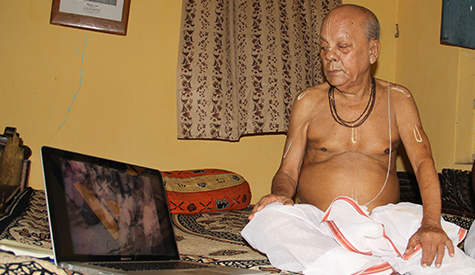
Manik Mitra Thakur watching photographs taken by Arnold Bake
That was the beginning of a relationship for us, for since that first meeting we have gone back many times to Mainadal, stayed overnight, recorded some beautiful music, while some of the Mitra Thakurs–Milan, Nirmalendu, Putul and so on–have become close friends. We did not have copies of Bake’s recordings with us when we first went to Mainadal (although now the British Library have taken the lead from our work and sent to the Mitra Thakurs digital copies of their recordings), but what we did have was some silent footage from Bake’s films (which we had from ARCE-AIIS) of what we thought was kirtan from Mainadal, although we were not so sure about them. So we wanted to check this out with the Mitra Thakurs. We also had a copy of a recording of Mainadal (Mayanadal, as written in the record sleevenotes) kirtan recorded 21 years after Arnold Bake, in February 1954 in Asansol, by Deben Bhattacharya. The singer was Nabagopal Mitra Thakur, who had also been recorded by Bake in 1933. This was from an LP released in 1966 by BAM in France.
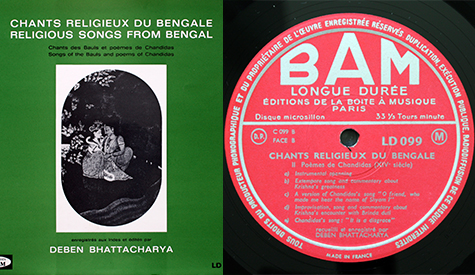
The cover and the record
So we played to the Mitra Thakurs these audio recordings and showed them the images of the record covers and silent footage we had with us. We went especially to the oldest family member, Manik Mitra Thakur, to record his response to these recordings and images, and what stories he might have to tell us. And, it was from here that we were directed towards Mongoldihi, for the octogenarian Manik Mitra Thakur and his sons identified the footage as being of the Ras festival of Mongoldihi, another village of Birbhum. Then he saw the photograph on Deben Bhattacharya’s record which had Nabagopal Mitra Thakur’s name in the caption. That is not Nabagopal, he said. The rest of the family said the same thing. (So then who is on the photograph of the Deben Bhattacharya album?)
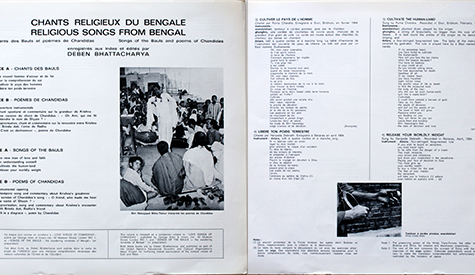
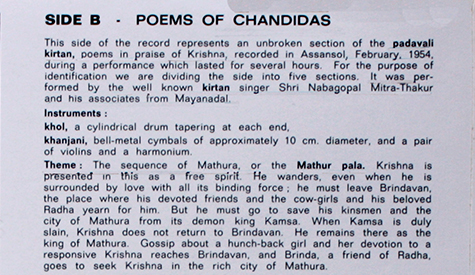
Liner notes from Deben Bhattacharya’s record
Anyway, We went round the village, meeting people, talking with them, while the song and dance of Nandotsav went on in the temple grounds. There were many people who had come to the festival. They sat listening to the music, watching the performance, and later all of us would be fed by the Mitra Thakurs; such has been the practice for hundreds of years. Sing, dance, eat and rejoice in the name of Gour or Gora.
ওহে গোরা, ওহে গোরা!
Nityananda Mitra Thakur, or Nitai as he was lovingly called by his family, one of the younger performers of this large kirtaniya family, had a natural charm about him. His movements were supple and as he sang and danced the story of Radha and Kirshna’s courtship–purbaraag or the flowering of love–that love and loving came to life. Nitai’s audiences savoured every gesture he made and every rasa which was aroused. This was performance before the initiated, so the audience knew where to feel what; they knew their rituals of appreciation. Here we have presented clips from that performance.
Later we talked with Nityananda about his performance, training, his lineage, showing him our finds–the Deben Bhatacharya album cover, the Bake footage, the names from BL. We talked about meeting again, about talking more. Something was begun, to be carried on later.
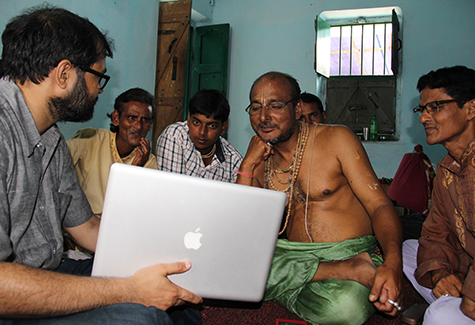
Nityananda Mitra Thakur watching old photographs
On 29 March 2015, I called Nitai, because I wanted to ask him something about Mongoldihi, where I remembered his wife had said she had family. Nitai’s phone rang a few times, then there was a voice on the other side. I introduced myself. There was a moment’s silence, I could hear a breeze hitting against the mic of the phone, so I asked Nitai if he was going somewhere and if I should call back later. Silence again. Are you not home, I asked. No, came the reply. The natural warmth of Nitai seemed to be missing and I wondered what might be wrong. So I asked if I was indeed talking with Nityanananda babu. ‘No,’ said the phone. ‘Nitai has died.’ I could not quite comprehend what he was saying. Beg your pardon? I said. I thought I must have heard wrong. The voice said again, ‘Nitai died last night, on stage, while he was performing. He had a heart attack. We have brought him to the crematorium now.’
So, that breeze and the crackling sounds were of fire and wind from the burning ghat.
This session is dedicated to our unfinished conversation with Nityanananda Mitra Thakur, who died at the age of 48, while in the act of singing and dancing his songs of love and devotion, for Krishna, Radha and Gora.
Written in 2016.
Post Script, added on 14 August 2017.
Referring to the photograph of Kaliakanta Mitra Thakur above, about which we were wondering if it might have been taken by Arnold Bake, we now know from Milan Mitra Thakur that it was indeed taken by him. The confirmation has come from Christain Poske, British Library and SOAS’ research scholar, who visited Mainadal earlier this year.
In this context, we refer to Bake’s letter to his mother, dated 16 August 1933. He wrote: ‘I brought a film but I did not use it because there were no performances during the day. I did take a number of pictures that I will send to Calcutta soon to have them developed. I hope they are nice, but I’m a little afraid . . .’ (Translation: Jan-Sijmen Zwarts). So, Kalianata’s was one of those pictures he had taken during that visit.
- Saptiguri, North Bengal. 27 November 2003. Nirmala Roy
- Bolpur, Birbhum. 25 November 2003. Nimai Chand Baul
- Kolkata. 4 September 2019. Purnadas on Nabani Das Baul
- Surma News Office, Quaker Street, East London. 27 February 2007. Ahmed Moyez
- Ambikapur, Faridpur, Bangladesh. 29 April 2006. Hajera Bibi
- Sylhet, Bangladesh. 22 April 2006. Chandrabati Roy Barman and Sushoma Das
- Sylhet, Bangladesh. 21 April 2006. Arkum Shah Mazar
- Sylhet, Bangladesh. 20-21 April 2006. Ruhi Thakur and others
- Jahajpur, Purulia. 27 February 2006. Naren Hansda and others
- Faridpur, Bangladesh. 24 January 2006. Binoy Nath
- Uttar Shobharampur, Faridpur, Bangladesh. 22 January 2006. Ibrahim Boyati
- Baotipara, Faridpur, Bangladesh. 21 January 2006. Kusumbala Mondal and others
- Kumar Nodi, Faridpur, Bangladesh. 21 January 2006. Idris Majhi and Sadek Ali
- Debicharan, Rangpur, Bangladesh 18 January 2006 Anurupa Roy & Mini Roy, Shopon Das
- Mahiganj, Rangpur, Bangladesh. 17 January 2006. Biswanath Mahanta & Digen Roy
- Chitarpur, Kotshila, Purulia. 28 November 2005. Musurabala
- Krishnai, Goalpara, Assam. 30 August 2005. Rahima Kolita
- Chandrapur,Cachar. 28 August 2005. Janmashtami
- Silchar, 25 August 2005, Barindra Das
- Kenduli,Birbhum. 14 January 2005. Fulmala Dasi
- Kenduli, Birbhum. 13 January 2005. Ashalata Mandal
- Shaspur, Birbhum. 8 January 2005. Golam Shah and sons Salam and Jamir
- Bhaddi, Purulia. 6 January 2005. Amulya Kumar, Hari Kumar
- Srimangal, Sylhet. 27 December 2004. Tea garden singers
- Sylhet, Bangladesh. 26 December 2004. Abdul Hamid
- Dhaka, Bangladesh. 24 December 2004. Ali Akbar
- Dhaka, Bangladesh. 23 December 2004. Monjila
- Changrabandha, Coochbehar. 16 December 2004. Abhay Roy
- Santiniketan, Birbhum 27 Nov 2004 Debdas Baul, Nandarani
- Tarapith, Birbhum. 14 October 2004. Kanai Das Baul


